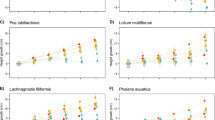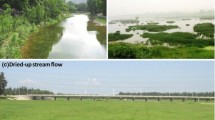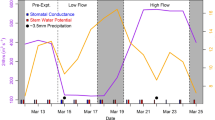Abstract
Changes to the timing of peak river flows caused by flow regulation affect riparian vegetation composition, but the mechanisms driving such vegetation changes are not well understood. We investigated experimentally the effects of timing of inundation on riparian plant growth and flowering. We collected 168 sods from 14 sites across five lowland rivers in south-eastern Australia. Plant cover and flowering within the sods were surveyed each season for a year. During this period, sods were inundated for 6 weeks in either early spring or in summer. Terrestrial plant taxa (which included most exotic species) senesced in response to inundation, regardless of its timing. In contrast, native amphibious species (particularly amphibious forbs) responded favourably to inundation in spring, but were unaffected by inundation in summer. Native and exotic emergent macrophytes responded favourably to inundation regardless of timing, and flowered frequently in both the spring- and the summer-inundation treatments. In contrast, many native annuals flowered only in the spring-inundation treatment, while more exotic grasses flowered in the summer-inundation treatment. In temperate climates, inundation in early spring followed by non-flooded conditions is likely to be important for promoting the growth of amphibious forbs and the recruitment and flowering of riparian annuals. Without inundation in spring, many terrestrial exotic weeds may flourish and set seed prior to any subsequent inundation (e.g. in summer). We contend that natural seasonal timing (i.e. winter-early spring) of flow peaks is important for the maintenance of native riverbank vegetation and reducing the extent of terrestrial exotic species within the riparian zone.



Similar content being viewed by others
References
Baldwin AH, Egnotovich MS, Clarke E (2001) Hydrologic change and vegetation of tidal freshwater marshes: field, greenhouse, and seed-bank experiments. Wetlands 21(4):519–531
Baskin CC, Baskin JM (1998) Seeds: ecology, biogeography, and evolution of dormancy and germination. Academic Press, San Diego, CA
Blom C, Voesenek L (1996) Flooding: the survival strategies of plants. Trends Ecol Evol 11(7):290–295
Bonilla-Warford CM, Zedler JB (2002) Potential for using native plant species in stormwater wetlands. Environ Manage 29(3):385–394
Brock MA, Casanova MT (1997) Plant life at the edges of wetlands; ecological responses to wetting and drying patterns. In: Klomp N, Lunt I (eds) Frontiers in ecology: building the links. Elsevier Science, Oxford, pp 181–192
Bunn SE, Arthington AH (2002) Basic principles and ecological consequences of altered flow regimes for aquatic biodiversity. Environ Manage 30(4):492–507
Casanova MT, Brock MA (2000) How do depth, duration and frequency of flooding influence the establishment of wetland plant communities? Plant Ecol 147(2):237–250
Catford JA, Downes BJ, Gippel CJ, Vesk PA (2011) Flow regulation reduces native plant cover and facilitates exotic invasion in riparian wetlands. J Appl Ecol 48(2):432–442
Chaneton EJ, Facelli JM, Leon RJC (1988) Floristic changes induced by flooding on grazed and ungrazed lowland grasslands in Argentina. J Range Manage 41(6):495–499
Clarke K, Gorley R (2001) PRIMER v5: user manual/tutorial. PRIMER-E Ltd., Plymouth
Crossle K, Brock MA (2002) How do water regime and clipping influence wetland plant establishment from seed banks and subsequent reproduction? Aquat Bot 74(1):43–56
Denton M, Ganf GG (1994) Response of juvenile Melaleuca halmaturorum to flooding: management implications for a seasonal wetland, Bool Lagoon, South Australia. Aust J Mar Freshw Res 45(8):1395–1408
Dixon MD (2003) Effects of flow pattern on riparian seedling recruitment on sandbars in the Wisconsin River, Wisconsin, USA. Wetlands 23(1):125–139
Froend RH, McComb AJ (1994) Distribution, productivity, production and reproductive phenology of emergent macrophytes in relation to water regimes at wetland of south-western Australia. Aust J Mar Freshw Res 45(8):1491–1508
Gerritsen J, Greening HS (1989) Marsh seed banks of the Okefenokee Swamp—effect of hydrologic regime and nutrients. Ecology 70(3):750–763
Glenz C, Schlaepfer R, Iorgulescu I, Kienast F (2006) Flooding tolerance of Central European tree and shrub species. For Ecol Manage 235(1–3):1–13
Greet J, Webb JA, Cousens RD (2011) The importance of seasonal flow timing for riparian vegetation dynamics: a systematic review using causal criteria analysis. Freshw Biol 56(7):1231–1247
Greet J, Cousens RD, Webb JA (2012a) More exotic and fewer native plant species: riverine vegetation patterns associated with altered seasonal flow patterns. River Res Appl. doi:10.1002/rra.2571
Greet J, Cousens RD, Webb JA (2012b) Flow regulation associated with riverine soil seed bank composition: potential implications for restoration J Veg Sci. doi:10.1111/j.1654-1103.2012.01445.x
Greet J, Cousens RD, Webb JA (2012c) Flow regulation affects temporal patterns of riverine plant seed dispersal: potential implications for plant recruitment. Freshw Biol. doi:10.1111/fwb.12028
Johansson ME, Nilsson C (2002) Responses of riparian plants to flooding in free-flowing and regulated boreal rivers: an experimental study. J Appl Ecol 39(6):971–986
Johnson WC (2000) Tree recruitment and survival in rivers: influence of hydrological processes. Hydrol Process 14(16–17):3051–3076
Klimesova J (1994) The effects of timing and duration of floods on growth of young plants of Phalaris arundinacea L. and Urtica dioca L.: an experimental study. Aquat Bot 48(1):21–29
Lytle DA, Poff NL (2004) Adaptation to natural flow regimes. Trends Ecol Evol 19(2):94–100
Naiman RJ, Décamps H (1997) The ecology of interfaces: riparian zones. Annu Rev Ecol Syst 28:621–658
Nilsson C, Svedmark M (2002) Basic principles and ecological consequences of changing water regimes: riparian plant communities. Environ Manage 30(4):468–480
Osawa T, Mitsuhashi H (2010) River confluences enhance riparian plant species diversity. Plant Ecol 209:95–108
Poff NL, Zimmerman JKH (2010) Ecological responses to altered flow regimes: a literature review to inform the science and management of environmental flows. Freshw Biol 55(1):194–205
Poff NL, Allan JD, Bain MB, Karr JR, Prestegaard KL, Richter BD, Sparks RE, Stromberg JC (1997) The natural flow regime. Bioscience 47(11):769–784
Reily PW, Johnson WC (1982) The effects of altered hydrologic regime on tree growth along the Missouri River in North-Dakota. Can J Bot 60(11):2410–2423
Richardson DM, Holmes PM, Esler KJ, Galatowitsch SM, Stromberg JC, Kirkman SP, Pysek P, Hobbs RJ (2007) Riparian vegetation: degradation, alien plant invasions, and restoration prospects. Divers Distrib 13(1):126–139
Roberts J (2002) Species-level knowledge of riverine and riparian plants: a constraint for determining flow requirements in the future. Aust J Water Res 5(1):21–31
Robertson AI, Bacon P, Heagney G (2001) The responses of floodplain primary production to flood frequency and timing. J Appl Ecol 38(1):126–136
Rogers K, Ralph TJ (2011) Floodplain wetland biota in the Murray-Darling basin: water and habitat requirements. CSIRO Publishing, Collingwood
Stokes K, Ward K, Colloff M (2010) Alterations in flood frequency increase exotic and native species richness of understorey vegetation in a temperate floodplain eucalypt forest. Plant Ecol 211(2):219–233
Streng DR, Glitzenstein JS, Harcombe PA (1989) Woody seedling dynamics in an East Texas floodplain forest. Ecol Monogr 59(2):177–204
Ström L, Jansson R, Nilsson C (2012) Projected changes in plant species richness and extent of riparian vegetation belts as a result of climate-driven hydrological changes along the Vindel River in Sweden. Freshw Biol 57:49–60
Stromberg JC, Patten DT (1990) Riparian vegetation instream flow requirements—a case-study from a diverted stream in the eastern Sierra-Nevada, California, USA. Environ Manage 14(2):185–194
Van der Sman AJM, Blom CWPM, Van de Steeg HM (1992) Phenology and seed production in Chenopodium rubrum, Rumex maritimus, and Rumex palustris as related to photoperiod in river forelands. Can J Bot 70(2):392–400
van Eck W, Lenssen JPM, van de Steeg HM, Blom C, de Kroon H (2006) Seasonal dependent effects of flooding on plant species survival and zonation: a comparative study of 10 terrestrial grassland species. Hydrobiologia 565:59–69
Voesenek L, Colmer TD, Pierik R, Millenaar FF, Peeters AJM (2006) How plants cope with complete submergence. New Phytol 170(2):213–226
Walsh N, Entwisle TJ (1994–99) Flora of Victoria, Vol. 2–4. Inkata Press, Melbourne
Walsh N, Stajsic V (2007) A census of the vascular plants of Victoria, vol 8. Royal Botanic Gardens, Melbourne
Warwick NWM, Brock MA (2003) Plant reproduction in temporary wetlands: the effects of seasonal timing, depth, and duration of flooding. Aquat Bot 77(2):153–167
Weisner SEB, Ekstam B (1993) Influence of germination time on juvenile performance of Phragmites australis on temporarily exposed bottoms—implications for the colonization of lake beds. Aquat Bot 45(2–3):107–118
Wilding JL, Barnett AG, Amor RL (1986) Crop weeds. Inkata Press, Melbourne
Acknowledgments
We thank William Bovill for his help with sod collection, Nick Osbourne and Sascha Andrusiak for their kind help and nursery expertise and Ashley MacQueen, William Bovill and two anonymous reviewers for their considered comments on an earlier version of this manuscript. Joe Greet was supported by a Melbourne Research Scholarship and an eWater top-up scholarship.
Author information
Authors and Affiliations
Corresponding author
Appendix
Appendix
See Table 6.
Rights and permissions
About this article
Cite this article
Greet, J., Cousens, R.D. & Webb, J.A. Seasonal timing of inundation affects riparian plant growth and flowering: implications for riparian vegetation composition. Plant Ecol 214, 87–101 (2013). https://doi.org/10.1007/s11258-012-0148-8
Received:
Accepted:
Published:
Issue Date:
DOI: https://doi.org/10.1007/s11258-012-0148-8




